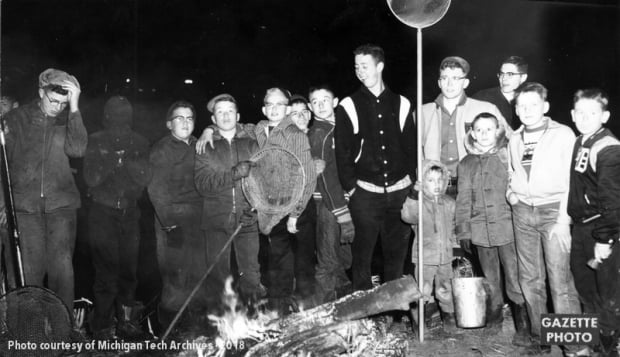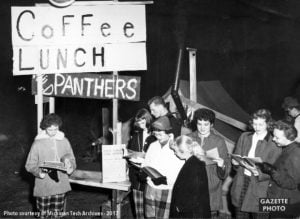
Spring in the Copper Country means that–finally!–the snow begins to melt, the songbirds return, and the smelt begin to run. When we talk about smelting at the Michigan Tech Archives, usually we’re referring to the process of turning milled copper into ingots under high heat. Spring brings a different meaning, one that’s more fun and more than a little fishy.
If you’ve lived around the Copper Country, odds are you’ve encountered a smelt or two, in the wild or on your plate. For the uninitiated, a smelt is a small fish about six to eight inches in length, though smelt elsewhere have been known to grow to more than two feet. The story goes that smelt were introduced into the St. Marys River downstate on four different occasions–unsuccessfully–as feed for sport salmon before someone stocked the inland Crystal Lake with them in 1912. It’s hard to find a small lake in Michigan that won’t connect with a Great Lake eventually. The smelt learned this as they traversed the waterways that led them to Lake Michigan, where they were first detected in 1923. By 1925, they had traveled to Lake Huron and by 1929 to Lake Ontario. They wouldn’t make it to Lake Erie until 1932. In between, in 1930, smelt showed up in Lake Superior.
For a time, the smelt population in the Lake Superior region remained fairly small. Though the first sport salmon struggled, other fish like lake trout found the smelt to be a tasty snack. As Sea Grant Minnesota explains, though, when invasive sea lampreys arrived in the Great Lakes, they went after the fish that had kept the smelt at bay. In classic predator-prey form, the number of smelt soared. Meanwhile, the burgeoning population of smelt contributed to the problem by feeding on the larvae of cisco, or lake herring, which were also food for the lake trout. As long as the trout remained at bay, the smelt could frolic freely in Lake Superior and the streams that fed her.

These predator-prey-invasive species dynamics helped to create the phenomenon of smelting, or smelt dipping, in the Upper Peninsula. With the warming temperatures of spring, as Fred Hartshorn explained in his piece for the publication Copper Country Anthem, “the jelly in the egg sack of female smelt starts to break up, telling her she should start up stream to spawn.” This movement, known colloquially as running, occurs when the water hits about 38 degrees Fahrenheit, generally in April. Locals eager to take advantage of the running smelt have descended on streams with hand nets for decades and especially since the population spiked in the middle of the last century, making a fishing trip virtually guaranteed to be successful. For many years, it wasn’t uncommon to see smelting parties of hundreds of fishermen descending on places like Chassell’s Pike River, armed with nets and ready to catch buckets full of the little fish to sell or eat.
Nowadays, the population of smelt is not nearly what it was in the heyday of smelt running, but people still flock to the streams in hopes of coming away with a bucket of the good stuff. According to the Michigan Department of Natural Resources, smelt season goes through May 31, so grab your net and your fishing license, and head on out while the weather is fine!
Well now as a Yooper I gotta tell you not ALL of us love those evil little things. My father did though, and I cleaned more than my share Smelt. My hands smelt of Smelt. Thanks MTU archives for the entertaining review of SMELT…not just for dessert anymore!